The Complete Walk In Cooler Guide 2025
The Complete Walk-In Cooler & Freezer Buyer's Guide 2025
How a $28,499 AmeriKooler Exceeded Retail MSRP at Auction | Analysis of 64 Sales with Expert Insights
When Walk-Ins Sell for More Than Retail: The AmeriKooler Story
Walk-in coolers and freezers typically depreciate 70-90% in secondary markets. Restaurant equipment loses value fast—a $20,000 new walk-in might fetch $3,000-$6,000 at auction if you're lucky. This depreciation curve is as predictable as sunrise.
Until it isn't.
The November 2025 Auction That Broke the Rules
AmeriKooler DW081677F-8/8-SC
8' x 16' x 7'7" Self-Contained Combo Box (Cooler + Freezer)
Brand New Scratch & Dent | Top-Mounted Refrigeration
$28,499.01
This exceeded the manufacturer's suggested retail price.
Equipment doesn't appreciate at auction. Yet here's an AmeriKooler combo box—admittedly brand new with minor cosmetic damage—commanding more than showroom pricing. Twelve unique bidders placed 87 bids over multiple days. This wasn't auction fever. This was informed demand meeting constrained supply.

AmeriKooler DW081677F-8/8-SC combo box—the walk-in that exceeded retail MSRP through auction, proving educated buyers recognize premium equipment value
Why did buyers pay over retail for equipment available through normal distribution channels? Five factors converged:
- Configuration desirability: Self-contained combo boxes solve the two most common cold storage needs (refrigeration and freezing) in a single footprint without requiring external refrigeration infrastructure.
- Standard sizing: Two 8' x 8' sections with shared wall fit standard restaurant layouts. Multiple bidders saw specifications and knew immediately: "It fits my space."
- Immediate availability: Next-day pickup versus 6-12 week lead times for new orders. When your walk-in fails during summer and you're losing thousands in spoiled inventory daily, waiting three months isn't an option.
- AmeriKooler reputation: Premium manufacturer known for rugged construction, efficient refrigeration, and engineered reliability. Buyers understood they were purchasing 15+ years of dependable service.
- Market scarcity: Self-contained combo boxes in standard sizes don't appear at auction frequently. When they do, operators with immediate need compete aggressively.
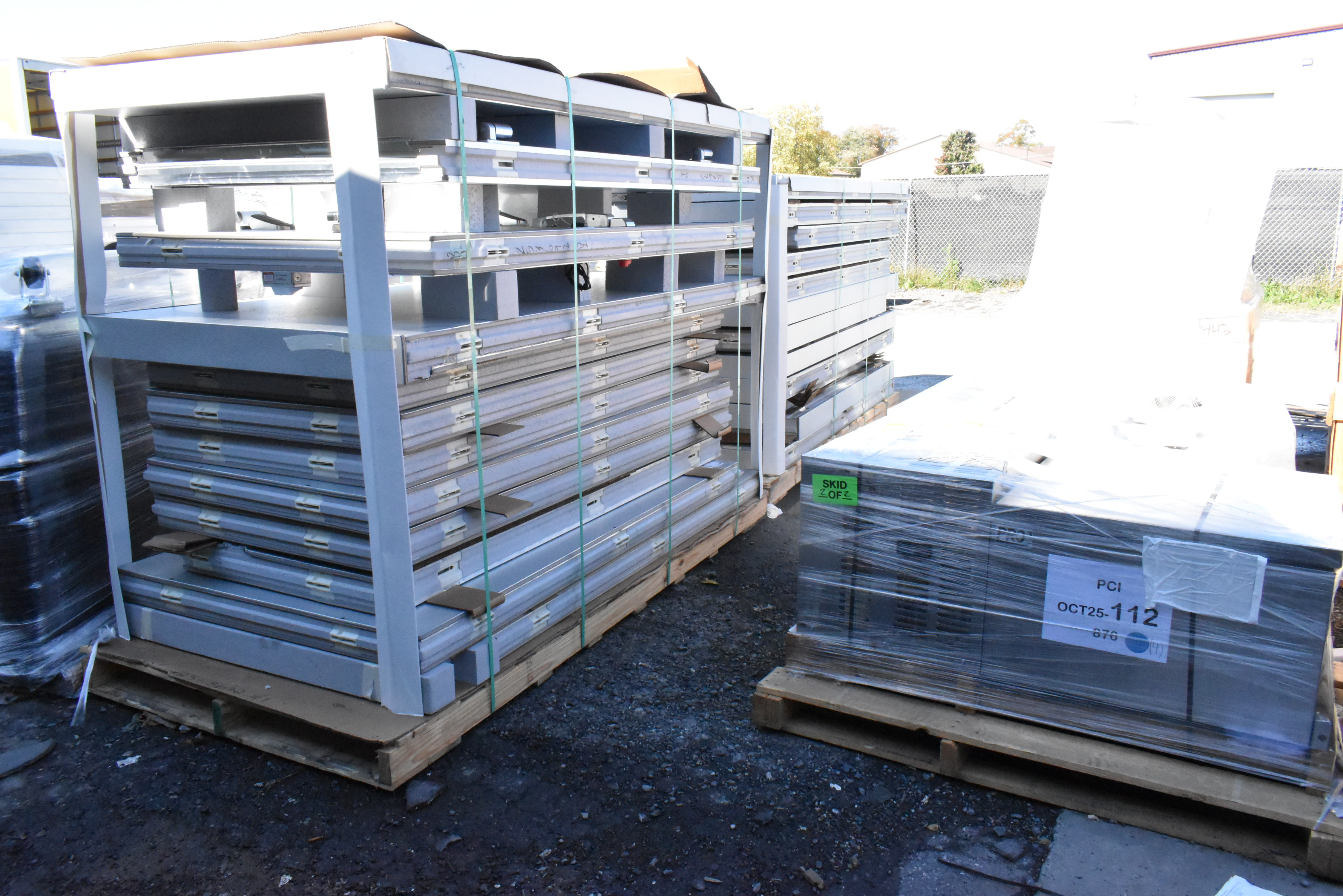
The AmeriKooler as sold—disassembled on pallets in original packaging, minor cosmetic damage invisible once installed, full functionality guaranteed
This sale validates a fundamental thesis: educated buyers pay premium pricing for quality equipment when value propositions align with operational needs. Our analysis of 64 walk-in cooler sales over 12 months reveals the market intelligence enabling informed purchasing decisions at auction.
Market Reality: 64 Walk-In Sales Analyzed
Auction Database Overview
- Total Sales: 64 complete walk-in coolers and freezers over 12 months
- Median Price: $1,425.50 (typical working unit)
- Mean Price: $1,702.18 (elevated by premium BNSD units)
- Price Range: $105 to $5,751
- 25th Percentile: $645 (salvage/parts tier)
- 75th Percentile: $2,275 (quality working units)
Configuration Breakdown: Self-contained units represent 54% of auction volume ($1,550 median), reflecting their popularity in small-to-medium operations lacking external refrigeration infrastructure. Combo boxes command $2,510 median versus $1,950 for cooler-only units—a 28% premium for dual functionality.
Configuration Analysis: What Sells at Auction
| Configuration Type | Units Sold | Median Price | Price Range | Market Share |
|---|---|---|---|---|
| Self-Contained | 35 | $1,550.01 | $310 - $5,751 | 54% |
| Combo (Cooler + Freezer) | 4 | $2,510.01 | $2,055 - $2,808 | 6% |
| Cooler Only | 20 | $1,950 | $385 - $5,751 | 31% |
| Freezer Only | 15 | $2,150 | $500 - $4,670 | 23% |
Self-contained units dominate auction volume because they serve the broadest operator base: chains, franchises, strip mall locations, and any facility lacking external refrigeration capacity. The 54% market share reflects this versatile configuration's appeal across diverse operational contexts.
Brand Performance Hierarchy
Brand reputation significantly impacts auction pricing. Premium manufacturers command consistent premiums through superior insulation quality, refrigeration system engineering, and documented longevity:
| Brand | Units Sold | Median Price | Price Range | Tier |
|---|---|---|---|---|
| Bally | 5 | $2,050.01 | $625 - $5,251 | Premium |
| Kolpak | 9 | $1,540 | $500 - $5,751 | Premium |
| Nor-Lake | 20 | $1,425.50 | $500 - $5,750 | Premium |
| AmeriKooler | 3 | $1,188 | $955 - $2,855 | Premium |
Nor-Lake leads auction volume (20 units, 31% market share) through decades of consistent quality and wide distribution. Bally commands highest median pricing ($2,050) reflecting brand reputation for digital monitoring capabilities and modular construction. Kolpak's wide price range ($500-$5,751) indicates brand appeal across all condition tiers—even damaged Kolpak units retain value for parts or alternative uses.
Brand Selection Reality
For established manufacturers—AmeriKooler, Kolpak, Nor-Lake, Bally, American Panel, Master-Bilt, Polar King—parts availability and service networks are adequate. Walk-in boxes are scaled-up refrigerators using identical core components throughout the industry.
Premium brands deliver consistent results through superior insulation (higher R-values), better panel construction (cam lock quality, gasket systems), and engineered refrigeration systems. But all major brands work when properly maintained. The difference appears over decades, not days.
Avoid unknown or imported brands. If parts sourcing becomes problematic, repair costs escalate dramatically. Proprietary components with limited North American distribution create maintenance nightmares.
Understanding Walk-In Configurations
Walk-in coolers and freezers span numerous configurations beyond simple "box with refrigeration." Understanding these variations helps match equipment to operational requirements without paying for unnecessary features or lacking critical capability.
Self-Contained vs Remote: The Fundamental Choice
The self-contained versus remote refrigeration decision determines installation complexity, operating efficiency, maintenance accessibility, and total cost of ownership. This choice shapes everything else about walk-in ownership.
Self-Contained Units: Turnkey Simplicity

Nor-Lake self-contained unit showing ceiling-mounted refrigeration—the all-in-one solution requiring no external infrastructure
Self-contained walk-ins integrate the entire refrigeration system into a single ceiling-mounted unit atop the insulated box. Evaporator, compressor, condenser, and controls occupy this packaged system. The unit arrives pre-charged with refrigerant, pre-wired, and ready for power connection after box assembly.
Self-Contained Advantages:
- Installation simplicity: No refrigerant line runs required. Box assembly, electrical connection, done. This eliminates the need for EPA-certified HVAC technicians to handle refrigerant charging—a substantial cost savings.
- Faster deployment: Assembly and commissioning typically completes in days rather than weeks. For operations opening on tight timelines or replacing failed units during peak season, this speed matters.
- Broader applicability: Chains like Subway operate in malls, strip centers, second-floor locations—spaces where external refrigeration installation is impractical or impossible. Self-contained units ensure cold storage capability regardless of facility constraints.
- Lower upfront cost: Elimination of refrigerant line installation, external mounting infrastructure, and additional labor typically saves $1,500-$3,000 versus comparable remote units.
Self-Contained Disadvantages:
- Heat remains in building: The refrigeration cycle generates substantial heat. Self-contained units exhaust this heat into the kitchen environment, forcing HVAC systems to work harder. In summer, this creates measurable cooling load increases.
- Maintenance accessibility challenges: The ceiling-mounted unit sits 8-10 feet high, frequently near kitchen hoods. Cleaning condenser coils, replacing fan motors, or servicing compressors requires ladders, clearance verification, and sometimes temporary equipment shutdowns during service hours.
- Reduced efficiency: Operating in warm kitchen environments (80-95°F ambient temperatures during service) forces refrigeration systems to work harder than outdoor-mounted remote units. This translates to higher operating costs and accelerated component wear.
- Shortened lifespan: The combination of heat, kitchen grease/moisture in air, and harder-working components typically reduces self-contained unit lifespan versus remote configurations. Expect 13-15 years versus 15-18+ for remote units under comparable maintenance.
Remote Units: Efficiency Through Separation
Remote refrigeration systems separate the heat-generating components (compressor and condenser) from the cold storage box. The evaporator mounts inside the walk-in, while compressor and condenser install externally—typically on roofs, behind buildings, or in dedicated mechanical areas.
Remote Advantages:
- Heat stays outside: Exhausting refrigeration heat outdoors eliminates the cooling load penalty. HVAC systems don't battle walk-in heat output, reducing overall facility energy consumption.
- Improved efficiency: Compressors and condensers operating in outdoor ambient temperatures (even summer heat) work more efficiently than those fighting 95°F kitchen environments. Lower condensing temperatures improve coefficient of performance across all operating conditions.
- Box fully encased: Without ceiling-mounted refrigeration, the walk-in top can be fully paneled and sealed. This eliminates top-access requirements, simplifies cleaning, and improves insulation effectiveness.
- Easier serviceability: External mounting locations provide ground-level or easily accessible service access. Technicians work on compressors and condensers without ladders, tight clearances, or navigating active kitchens.
- Extended lifespan: Operating in better conditions with easier maintenance access, remote units typically deliver 15-18+ years of service versus 13-15 for self-contained configurations.
Remote Disadvantages:
- Installation complexity: Refrigerant lines must be run from external unit to walk-in evaporator. This requires EPA-certified technicians, line sizing calculations, proper insulation, leak testing, and system charging. Installation costs increase $2,000-$4,000 versus self-contained units.
- Facility requirements: Not all locations accommodate external refrigeration mounting. Leased spaces, multi-tenant buildings, or urban locations may lack suitable roof access or ground space for compressor/condenser placement.
- Weather exposure: External components face rain, snow, sun, and temperature extremes. While designed for outdoor use, this exposure requires quality installation (proper mounting, drainage, weather protection) to prevent premature failure.
Configuration Selection Framework
Choose Self-Contained When:
- Facility lacks external refrigeration mounting capability
- Installation timeline is critical (rapid deployment required)
- Upfront cost minimization is priority
- Operation is chain/franchise with standardized self-contained specifications
Choose Remote When:
- External mounting space available (roof, mechanical area, behind building)
- Operating cost optimization is priority (energy efficiency)
- Kitchen heat load reduction matters (HVAC capacity constrained)
- Long-term ownership expected (15-18+ year horizon)
Combo Boxes: Dual Functionality in Single Footprint
Combination walk-ins provide both refrigeration (32-40°F) and freezing (0-10°F) in adjacent compartments. The auction data shows combo boxes command $2,510 median versus $1,950 for cooler-only units—a 28% premium reflecting dual-functionality value.

Disassembled walk-in panels showing cam lock connections—combo boxes share walls between refrigerated and frozen sections, maximizing space efficiency
Why Combo Boxes Command Premium Pricing:
- Operational necessity: Most restaurants need both refrigerated and frozen storage. The combo box delivers both requirements in optimized footprint, eliminating the need for two separate units consuming double the floor space.
- Shared wall efficiency: The partition wall between cooler and freezer sections is already insulated. Rather than requiring two complete boxes with eight walls total, combo configurations use seven walls (one shared), reducing material costs and space requirements.
- Workflow optimization: Pass-through designs position the freezer door inside the refrigerated section. This enables proper thawing procedures: moving frozen product to refrigerated space for controlled, food-safe thawing. The workflow becomes streamlined rather than requiring transfers between separate units.
- Energy advantages: Opening the freezer door from within the refrigerated space (pass-through design) means cold air released during door opening enters a 35°F environment rather than 75°F kitchen space. While savings are modest, they accumulate over thousands of door cycles annually.
Pass-Through vs Separate Entry Designs:
Pass-through combo boxes feature the freezer door accessible only from inside the cooler section. This configuration suits operations where refrigerated product flow exceeds frozen product flow—the cooler becomes the primary access point with freezer serving as secondary storage.
Separate entry designs provide independent exterior doors for both cooler and freezer sections. This configuration suits operations requiring frequent simultaneous access to both frozen and refrigerated storage, or where staff workflow benefits from independent entry points.
The choice between pass-through and separate entry is driven by kitchen layout and operational workflow rather than inherent advantages of either design. Both function identically from refrigeration performance standpoints.
Floor vs Floorless Configurations
Walk-ins are available with or without integrated floor panels. This seemingly simple distinction creates significant implications for installation, maintenance, and longevity.
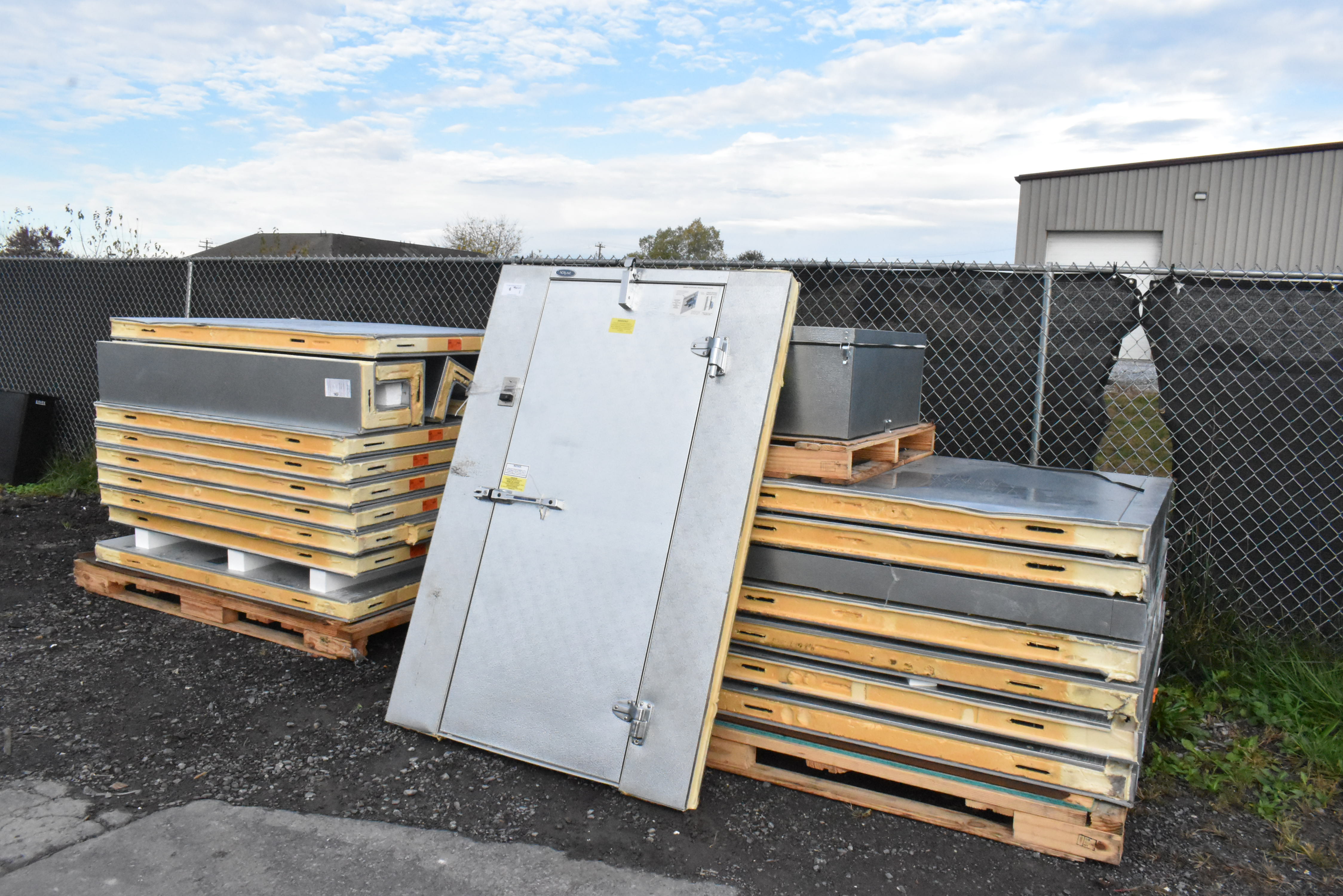
Walk-in floor panels (stacked) showing insulated construction—floors take the most abuse but enable installation flexibility
Units With Floors:
Integrated floor panels create a complete insulated enclosure. The floor typically includes a ramp for smooth cart access and leveling on uneven surfaces. These units install anywhere with adequate structural support—existing floors, elevated platforms, even outdoor locations.
Floor advantages include installation flexibility (no foundation requirements), complete insulation envelope (preventing ground-sourced heat transfer), and moisture barriers (protecting against condensation and corrosion where walk-in meets building floor). The ramp eliminates tripping hazards and enables wheeled cart access for stocking and cleaning.
The critical disadvantage: floors take tremendous abuse. Moisture, weight, corrosion, and physical wear concentrate on floor panels. When pulling walk-ins from closing restaurants, floors are frequently the most damaged component—rusted, corroded, delaminated, or structurally compromised. A used unit with pristine floor panels indicates exceptional maintenance; budget accordingly.
Floorless Units:
Walk-ins without integrated floors install directly on concrete slabs. This configuration requires specific conditions: properly leveled slab, adequate insulation between slab and wall panels (preventing cold air escape), and critically—no basement or crawlspace below.
The "nothing below" requirement stems from moisture physics. Cold walk-in floors meeting warmer underneath spaces create condensation. This moisture accumulates, causes mold growth, and accelerates corrosion of metal panels where they contact floors. Floorless walk-ins work perfectly when installed on ground-level slabs with proper vapor barriers. They fail dramatically when installed on second floors or above basements.
Cost savings are modest—$500-$1,500 depending on walk-in size. But for operators with suitable facilities, floorless configurations eliminate the component most prone to failure while simplifying installation.
Floor Selection Decision Framework
Choose Floored Units When: Installing outdoors, placing on existing floors, working with uneven surfaces, or lacking perfect ground-level concrete slabs. The installation flexibility justifies higher cost and maintenance burden.
Choose Floorless When: Installing on properly prepared, perfectly level ground-level concrete slabs with vapor barriers and no spaces below. The elimination of the highest-maintenance component provides long-term advantages.
Never install floorless units: Above basements, on second floors, over crawlspaces, or on uneven surfaces. Moisture and structural problems will develop, causing premature failure.
Indoor vs Outdoor Installation Strategy
Walk-ins are engineered as sealed, insulated, weathertight enclosures. This enables a space-maximization strategy: outdoor installation with only door and frame positioned in kitchen.
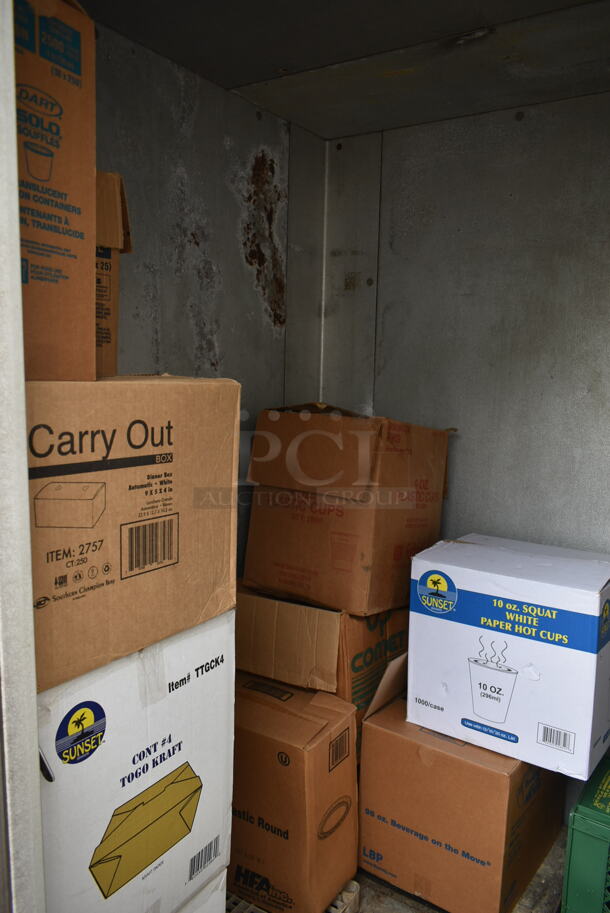
Walk-in installed outdoors for dry storage—demonstrating the weathertight construction enabling exterior placement without premium indoor space consumption
This configuration expands cold storage capacity without consuming premium kitchen square footage. The walk-in occupies less-valuable exterior space (behind building, side yard, parking lot edge) while door access remains convenient from kitchen. For operations constrained by dining room, bar, or kitchen footprint limitations, this strategy provides substantial capacity increases without facility expansion.
Outdoor Installation Requirements:
- Floor panels mandatory: Temperature variations and ground freeze/thaw cycles make floorless configurations unsuitable for outdoor use. Integrated floors provide necessary structural stability and insulation.
- Roof protection from ponding: Walk-in tops must shed water. Flat surfaces that allow pooling (ponding) create corrosion risk and potential structural damage. Proper installation includes drainage consideration or roof slope to prevent water accumulation.
- Panel material considerations: While most walk-ins use galvanized steel (G-90 coated for corrosion resistance) or galvalume (zinc-aluminum alloy), units intended for direct weather exposure benefit from stainless steel or fiberglass exterior panels. These materials resist corrosion better under sustained moisture exposure.
- Refrigeration location: Self-contained units can operate outdoors with proper weather shielding. The ceiling-mounted system stays protected by walk-in roof structure. Remote units obviously accommodate outdoor installation since compressor/condenser already mount externally.
Outdoor walk-ins experience accelerated wear versus indoor units—but this timeline spans decades rather than years. With proper installation and regular maintenance, outdoor units deliver 12-15 years of service versus 15-18+ for comparable indoor installations. For operations gaining 150-300 cubic feet of additional storage without facility renovation, this tradeoff makes excellent sense.
Assembly, Installation, and the Cam Lock System
Walk-in coolers and freezers arrive at auction disassembled. Understanding assembly systems, installation requirements, and the cam lock mechanism enables accurate condition assessment and realistic bidding.
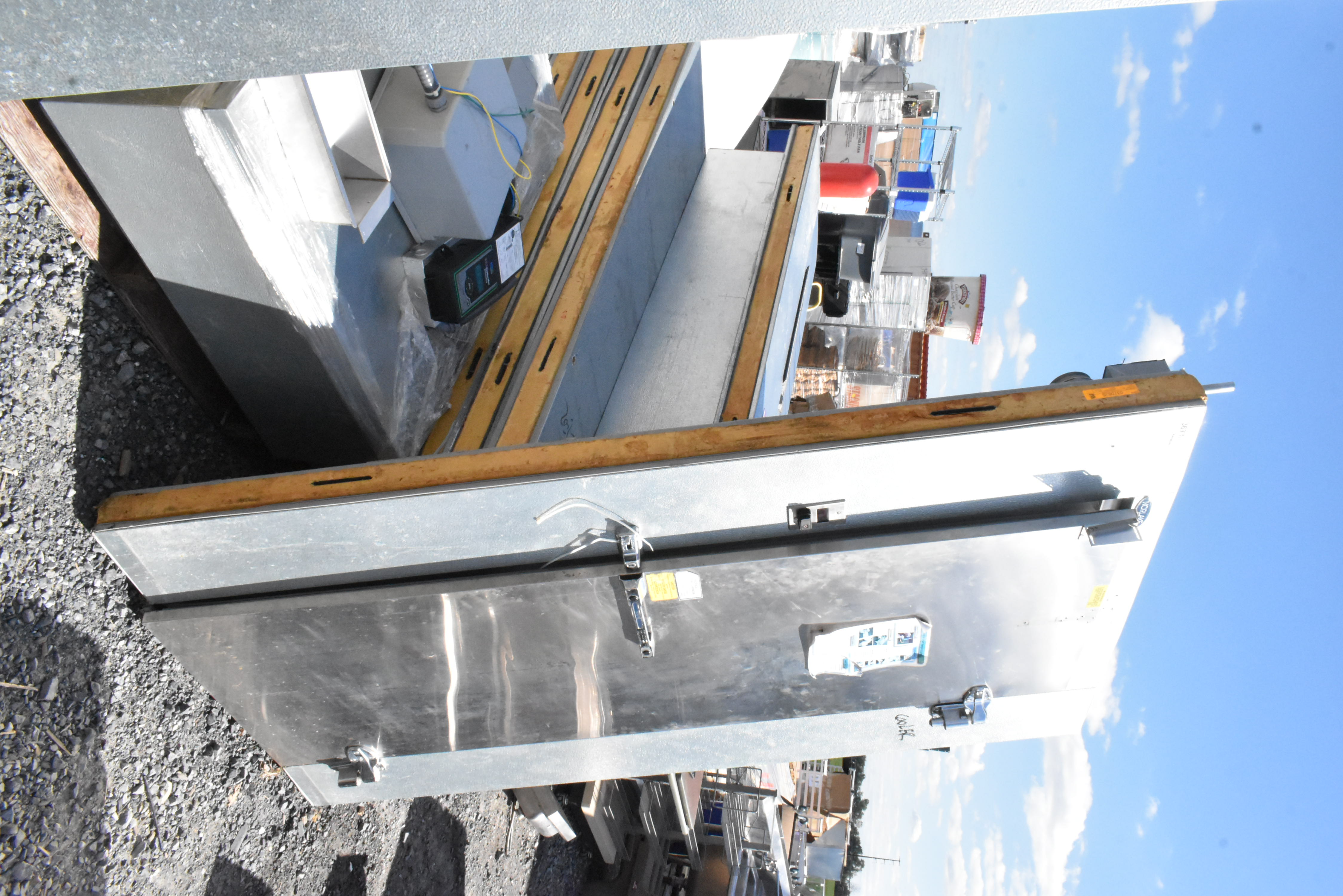
Walk-in as sold at auction—completely disassembled panels, door, and components allowing thorough condition inspection before bidding
The Cam Lock Assembly System
Walk-in panels connect via cam lock mechanisms rather than welding or bolting. This system enables complete disassembly and reassembly without damaging panels or compromising insulation—critical for auction equipment that will be moved and reinstalled.
How Cam Locks Work:
One panel features a hook with pivot mechanism. The adjacent panel has a matching bar. When the cam lock tool is inserted and rotated, the hook pivots to engage the bar, drawing panels together and locking them in tight contact. Each panel junction typically uses 3-10 cam locks depending on panel height and manufacturer design.

Panel interior showing insulation quality and cam lock connection points—the mechanical system enabling complete disassembly without insulation damage
Why Cam Locks Instead of Alternatives:
- Complete surface cleanliness: Cam locks mount flush with panel surfaces. Bolts or external fasteners would create gaps, crevices, and raised areas where dirt, grease, and bacteria accumulate—unacceptable in food service environments.
- Insulation protection: Welding is impossible—the heat would damage insulation foam sandwiched between metal panel skins. Cam locks connect panels mechanically without heat or insulation compression.
- Disassembly capability: Walk-ins move when restaurants close or relocate. Cam lock systems enable complete disassembly, transport, and reassembly without panel damage. Welded or permanently fastened boxes would be single-use installations.
- Gasket compression: Properly engaged cam locks draw panels together with consistent pressure, compressing gaskets uniformly around the entire perimeter. This creates airtight seals critical for thermal efficiency and humidity control.
Cam Lock Tool Requirements:

Cam lock tool (hex wrench style)—inexpensive, universal tool required for walk-in assembly and disassembly
The cam lock tool resembles an oversized Allen key with specific angles for engaging cam mechanisms. These tools are universal across manufacturers—one tool works for any walk-in brand using cam lock systems (which is essentially all of them). Tools cost $15-$40 and are readily available from walk-in parts suppliers.
Assembly Process and Common Mistakes
Walk-in assembly follows consistent sequence: floor (if present), walls, door/frame, ceiling (or self-contained refrigeration unit). Disassembly reverses this order.
The Critical Rule: Engage Every Cam Lock
Walk-ins have dozens to hundreds of cam locks depending on size. Each one must be fully engaged and tightened. This takes time—assembly of a 10'x10' walk-in involves 3-4 hours of methodical cam lock engagement even for experienced crews.
The temptation: engage every third cam lock, seal gaps with caulk or silicone, call it done. This shortcuts process reduces assembly time to 90 minutes.
The consequence: premature failure. Cam locks not properly engaged create uneven pressure on gaskets, allowing air infiltration. Moisture enters through imperfect seals, condensing inside insulation where it causes panel delamination and cam lock corrosion. Caulking gaps masks poor assembly while preventing proper panel contact. The walk-in develops issues within months rather than providing decades of service.
Tile Installation Problems:
Some operators tile around walk-in bases where units meet facility floors. This seems logical—protecting floors, creating finished appearance, eliminating gaps. The problems develop later:
- Disassembly becomes destructive: When the walk-in needs moving (restaurant closes, equipment fails, facility renovates), tiles must be broken out. This damages both tiles and walk-in panel bases.
- Moisture trapping: Grout and tiles against panel bases restrict airflow and trap moisture. This creates conditions for mold, mildew, and corrosion exactly where panels contact floors—the highest-wear junction point.
- Hidden degradation: Because damage occurs behind tiles and beneath panels, problems remain invisible until advanced stages. By discovery, repair costs often exceed walk-in replacement costs.
Professional Installation vs DIY
Experienced operators can assemble walk-in boxes. The cam lock system is mechanical and straightforward. However, complete installation requires multiple specialized skills:
Skills Required for Complete Installation:
- Site preparation: Level foundation, moisture barriers, structural capacity verification
- Box assembly: Panel handling, cam lock engagement, gasket alignment, door installation
- Refrigeration (remote units): Line runs, insulation, leak testing, evacuation, charging—requires EPA certification
- Electrical: Power supply, disconnect installation, control wiring, grounding, code compliance
For self-contained units, operators can handle box assembly and potentially electrical (if qualified). Final electrical connections and refrigeration troubleshooting still benefit from professional service.
For remote units, refrigerant handling is non-negotiable professional territory. Attempting DIY refrigerant work without EPA certification is illegal and dangerous. The cost savings don't justify the risks.
Installation Cost Reality
Self-Contained Units: Budget $1,500-$3,000 for professional installation including site prep, box assembly, and electrical connections. This assumes suitable facility (level floor, adequate power) without major infrastructure work.
Remote Units: Budget $3,500-$6,000 for complete installation including box assembly, refrigerant line runs, system charging, and electrical. Costs escalate with distance between walk-in and external unit location, difficult line routing, or inadequate existing power.
Infrastructure Upgrades: Foundation work ($500-$2,000), electrical service upgrades ($1,000-$5,000), or structural modifications add substantially to installation costs. Verify facility readiness before purchasing equipment.
Critical Inspection Points for Auction Buyers
Walk-ins sell disassembled at auction, enabling thorough condition inspection impossible with assembled units. Visual assessment of panels, insulation, refrigeration components, and hardware provides reliable indicators of maintenance history and remaining service life.
Panel Condition: The Foundation of Value
Walk-in value starts with panel integrity. Inspect each panel systematically during auction preview.
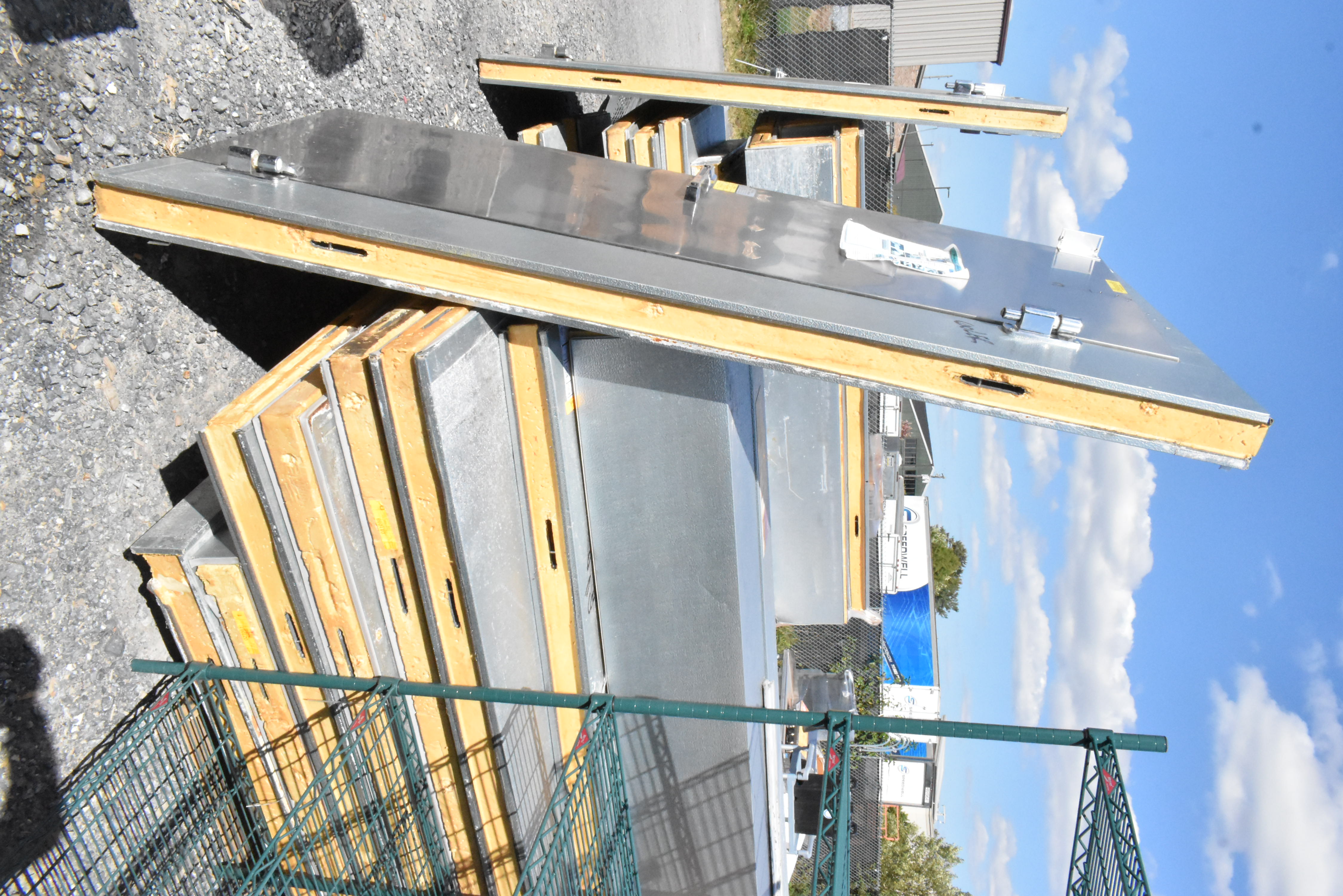
Good condition used panels—minimal rust, intact gaskets, clean surfaces indicating proper maintenance and remaining service life
Surface Condition: Clean, rust-free exterior surfaces indicate indoor installation with proper maintenance. Light surface rust on steel panels suggests outdoor use or moist environments but isn't disqualifying if corrosion hasn't penetrated protective coatings. Heavy rust, flaking paint, or corrosion pitting indicates advanced deterioration.
Insulation Assessment: Disassembled panels allow direct insulation inspection. Quality insulation appears uniform, properly bonded to panel skins, without compression, delamination, or moisture damage. Insulation types vary—polyurethane foam delivers higher R-values per inch than polystyrene but costs more. Both work effectively when intact.
Moisture-damaged insulation appears compressed, discolored, or crumbly. Water infiltration destroys insulation effectiveness and indicates gasket failure or improper assembly during previous installation. Units with significant insulation damage require re-paneling or serve only alternative uses (dry storage, smoker conversion, parts harvesting).
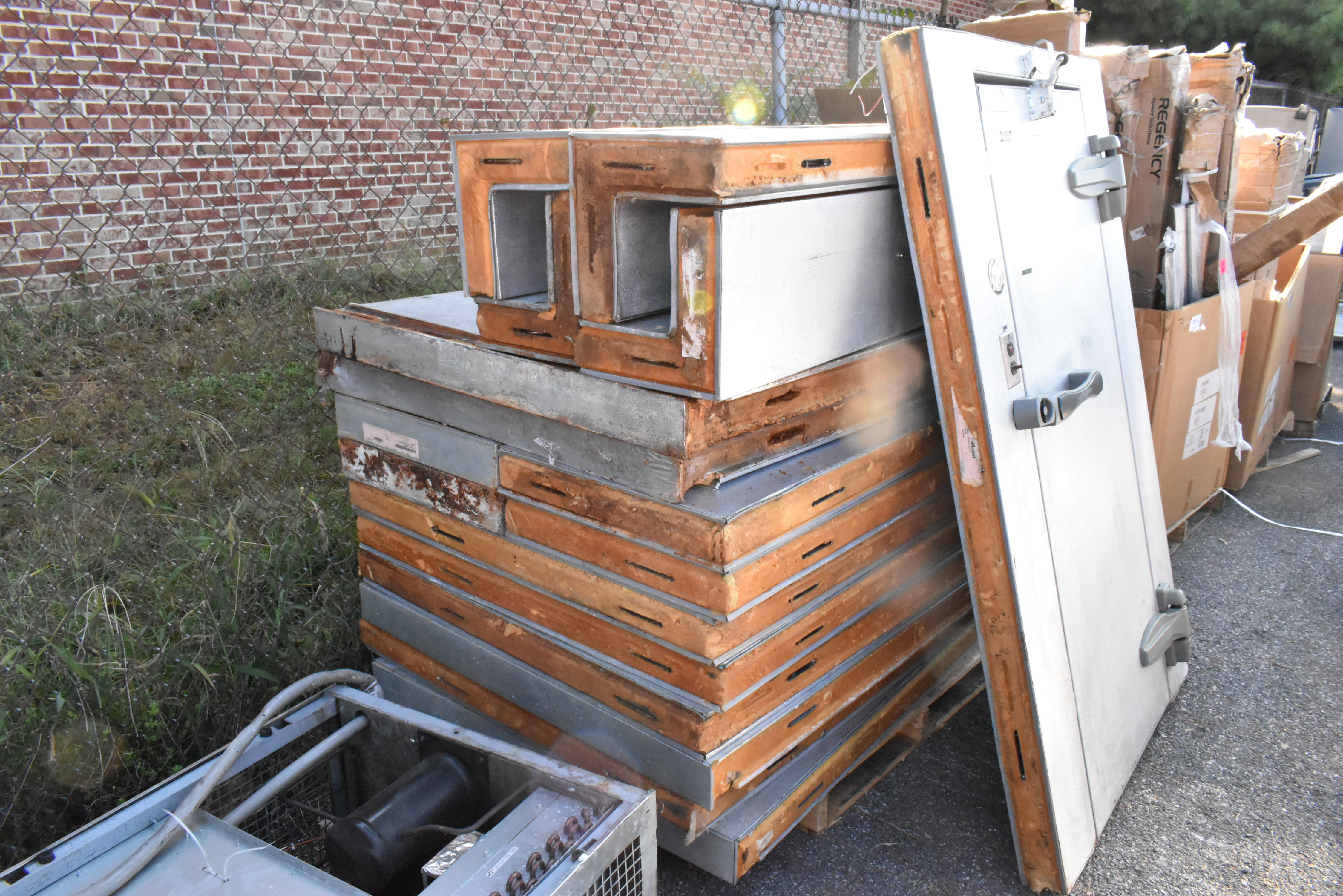
Mid-condition unit showing corrosion but structurally sound—refurbishment candidate requiring cleaning, gasket replacement, and rust treatment
Cam Lock Condition: The Telltale Indicator
Cam lock condition reveals maintenance history more reliably than almost any other inspection point. Pristine cam locks indicate proper assembly, regular maintenance, and dry operating environment. Rusty, corroded, or frozen cam locks tell different stories.
Rust on Cam Locks: Corrosion develops when moisture infiltrates through imperfect gasket seals, condenses inside panels, and contacts metal cam lock components. This indicates either improper original assembly (cam locks not fully engaged, allowing air/moisture infiltration) or deferred gasket maintenance (worn gaskets allowing environmental moisture entry).
Light surface rust on accessible cam locks is repairable—disassemble, clean with wire brush, apply rust treatment, reassemble properly. Heavy corrosion that freezes cam locks in place or causes cam lock failure (broken hooks, stripped threads, damaged mounting points) indicates severe moisture problems throughout the unit.
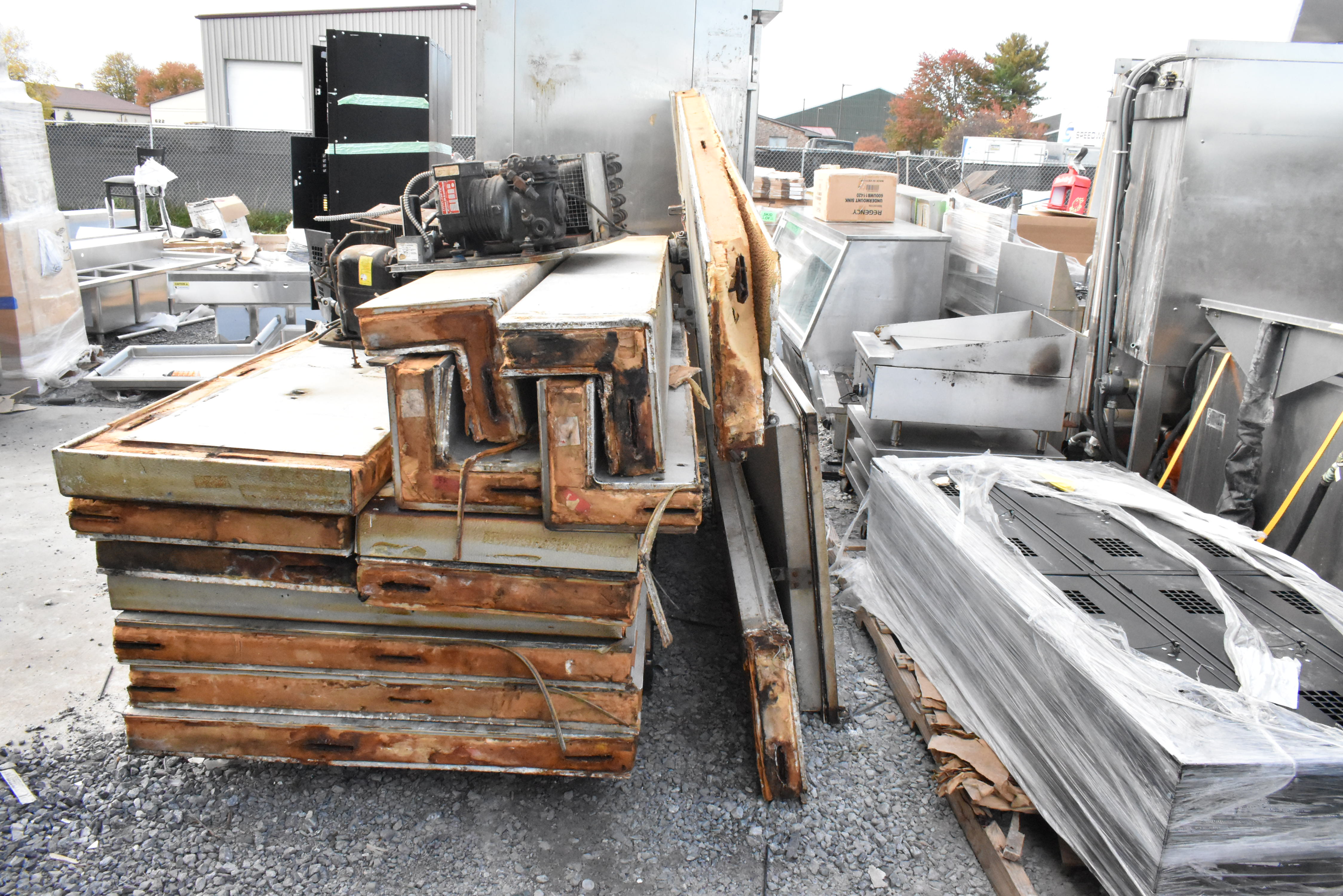
Bad condition unit—rusty cam locks, mold, panel separation—not salvageable for food service but still valuable for parts, alternative uses, or panel replacement inventory
Door and Gasket Assessment
Doors are the highest-wear component on any walk-in. Frequent opening, physical abuse, and gasket degradation make doors the #1 maintenance and replacement item.

Walk-in door and frame showing gasket, hinges, latch hardware—the highest-maintenance components requiring regular replacement
Door Condition Checklist:
- Gasket integrity: Compressible gaskets should show minimal compression set (permanent deformation). Cracked, torn, or permanently compressed gaskets require replacement ($50-$150 depending on door size).
- Hinge operation: Doors should swing smoothly without binding. Worn hinges cause doors to sag, preventing proper closure and gasket seal. Hinge replacement is straightforward but adds cost.
- Latch hardware: Check that latches engage fully and release smoothly. Worn or damaged latches compromise food safety (doors don't seal properly) and create employee frustration.
- Panel condition: Dents, scratches, and cosmetic damage don't affect function. Cracks, holes, or structural damage in door panels compromise insulation and require door replacement ($300-$800+ depending on size).
- Safety release: Interior safety release handles enable emergency exit from inside walk-ins. This safety feature is code-required in most jurisdictions. Verify presence and functionality.

Interior safety release handle—code-required emergency exit mechanism, verify presence and functionality during inspection

Open walk-in door showing interior construction and gasket contact surfaces—inspect for moisture damage, proper sealing, and structural integrity
Refrigeration System Evaluation
Refrigeration assessment at auction relies primarily on visual inspection since units aren't powered or connected.
Self-Contained Units: Inspect the ceiling-mounted refrigeration package. Clean condenser coils indicate proper maintenance—the single best predictor of refrigeration system health. Dirty, grease-caked condenser coils covered in dust and kitchen residue show maintenance neglect. This doesn't guarantee compressor failure, but it reduces confidence significantly.
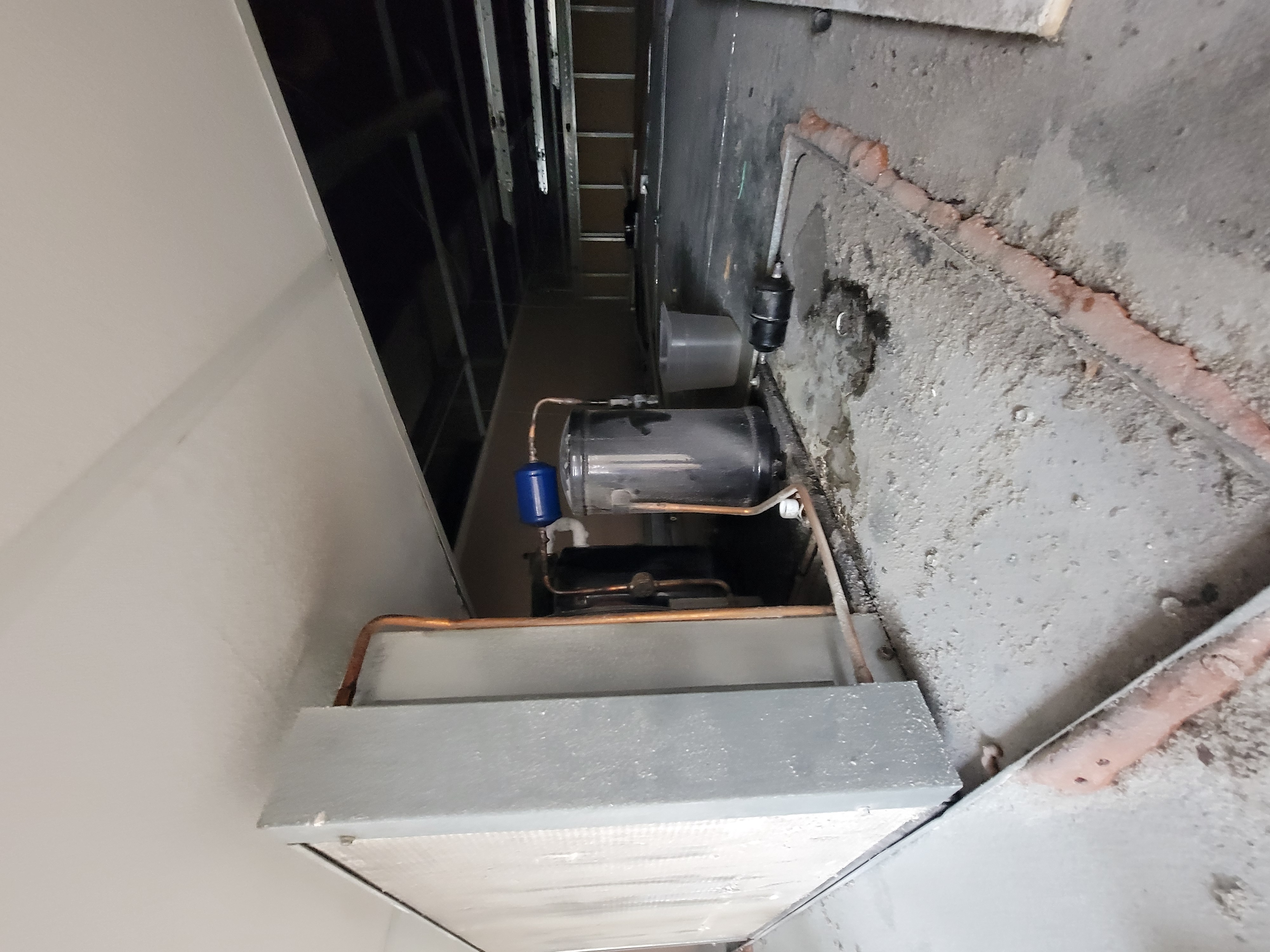
Condensing unit in dusty location but reasonably clean—acceptable condition indicating some maintenance attention, though deeper cleaning recommended before commissioning
Check for obvious damage: bent fan blades, damaged coil fins, broken mounting brackets, disconnected wiring. Cosmetic cabinet damage doesn't affect function. Damaged coils, broken compressors, or missing components do matter.
Assume self-contained units require refrigerant recharging after transport. Vibration during moving frequently causes small refrigerant leaks even in properly functioning systems. Budget $200-$500 for professional leak check and recharge after installation.
Remote Units: Verify all components are present. Walk-in includes evaporator (should be visible inside box or separately packaged). External compressor and condenser may or may not be included in auction lot—description should clarify. If external components aren't included, factor $1,500-$4,000 for replacement compressor/condenser units depending on size and capacity.
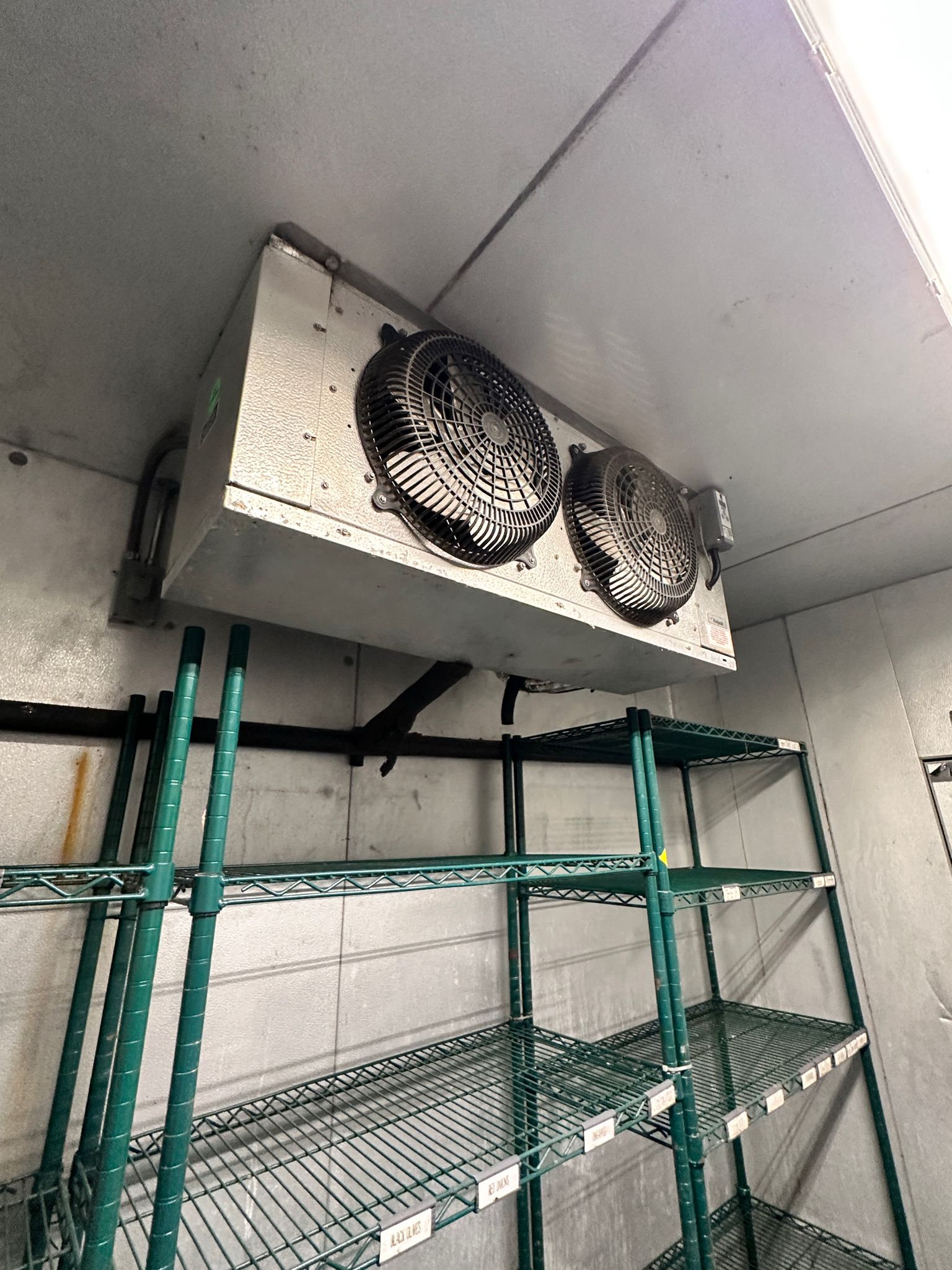
Evaporator unit hanging inside walk-in—the interior refrigeration component for remote systems, verify presence and condition
Remote systems require professional commissioning. Line runs, leak testing, evacuation, and refrigerant charging demand EPA certification. Plan accordingly when bidding on remote units.
Refrigerant Type Considerations: Older units using R-22 refrigerant face compliance challenges. R-22 production ceased in 2020, making servicing these units expensive and potentially impossible. Units manufactured after 2010 typically use R-404A, R-448A, or other approved refrigerants with assured long-term availability. When possible, verify refrigerant type before bidding on older equipment.
Completeness Verification: The Most Critical Check
Incomplete walk-ins create expensive headaches. Verifying completeness during preview prevents post-purchase surprises.
Essential Components Checklist:
- Panel count: Verify panel quantity matches walk-in dimensions. An 8'x10' walk-in requires specific panel counts for walls. Missing panels make assembly impossible. Consult manufacturer specifications (usually available online) to verify panel counts for stated dimensions.
- Door and frame: Complete door with frame, hinges, latch, and gasket. Doors are expensive to source separately ($300-$800+).
- Floor panels (if applicable): Floored units require all floor panels plus typically a ramp section. Missing floor panels are difficult to source and expensive to fabricate.
- Refrigeration components: Self-contained units should have ceiling-mounted package present. Remote units need evaporator; check if compressor/condenser included or not.
- Electrical components: Verify thermostats, control boxes, and wiring harnesses are present. These are replaceable but add cost if missing.
The Incomplete Unit Decision
Missing one or two panels? Sometimes fabrication is possible through walk-in service companies. Cost varies dramatically depending on panel size and insulation specifications but typically runs $200-$500 per panel for standard sizes.
Missing door? Factor $300-$800 for replacement. Missing refrigeration system entirely? Factor $1,500-$4,000 for complete new system.
At what point does incomplete unit become uneconomical? When replacement component costs approach or exceed $1,500-$2,000, the value proposition disappears unless walk-in is premium brand in otherwise excellent condition. Budget carefully and bid accordingly.
Brand Intelligence: What Quality Looks Like
Walk-in brand selection determines insulation effectiveness, refrigeration efficiency, panel longevity, and parts availability over decades of service. Premium brands command auction premiums through documented performance advantages.
Premium Tier: The Industry Standards
Kolpak: Known for high-efficiency refrigeration systems and straightforward maintenance. Kolpak's strength lies in custom solutions—they excel at designing walk-ins for specific footprints and unusual space constraints. Their modular panel systems enable efficient expansion or reconfiguration. Pricing is competitive for the quality delivered, making Kolpak a solid choice across operational scales. Auction presence is strong (9 units, $1,540 median) with wide price ranges reflecting brand appeal across all condition tiers.
AmeriKooler: Renowned for rugged construction and installation simplicity. AmeriKooler units frequently feature self-contained refrigeration, appealing to operators prioritizing turnkey deployment. Panel quality is excellent—superior cam lock engineering and gasket systems create reliable long-term seals. The $28,499 auction sale exceeding retail MSRP validates market recognition of AmeriKooler's quality positioning. When buyers see AmeriKooler at auction, they understand they're purchasing 15+ years of dependable service.
Nor-Lake: Industry leader in innovative design with emphasis on energy efficiency and expandability. Nor-Lake pioneered modular designs enabling panel additions for walk-in expansion without complete replacement. Their digital control systems offer remote monitoring and adjustment capabilities—valuable for multi-unit operations seeking centralized oversight. Auction volume is highest (20 units, 31% market share) at $1,425.50 median, reflecting widespread brand deployment and consistent quality across decades.
Master-Bilt: Specialists in large-scale applications. While Master-Bilt manufactures walk-ins across all size ranges, their reputation centers on distribution center and cold storage facility installations. These units are engineered for challenging environments—sustained heavy use, extreme temperature ranges, industrial applications. For restaurant operators, Master-Bilt represents overbuilt reliability. You're purchasing capacity and durability exceeding typical restaurant requirements, providing comfortable operating margins.
Bally: Technology-forward manufacturer embracing digital monitoring, IoT connectivity, and advanced controls. Bally's modular structure enables efficient serviceability and component replacement. Their reliability reputation combined with modern features makes Bally units attractive to operators seeking contemporary walk-in capabilities. Auction median of $2,050 reflects quality positioning and advanced feature sets.
American Panel: Another digitally-focused manufacturer offering innovative insulation solutions and advanced monitoring. American Panel competes directly with Bally in the technology-enabled walk-in segment. Their insulation engineering emphasizes thermal performance and energy efficiency, appealing to cost-conscious operators focused on long-term operating expenses.
Specialty Applications
Polar King: The outdoor walk-in specialist. Polar King units feature fiberglass construction specifically engineered for direct weather exposure. These walk-ins install in parking lots, behind buildings, or anywhere outdoor expansion makes sense. The fiberglass construction resists corrosion indefinitely, justifying premium pricing for permanent outdoor installations. If outdoor placement is planned, Polar King represents the purpose-built solution.
Imperial Brown: Custom buildout specialists. Imperial Brown excels at unusual sizes, non-standard configurations, and space-constrained solutions. At auction, the critical verification is confirming the walk-in dimensions and shape match your facility requirements. Imperial Brown custom units don't follow standard dimensional patterns, making "fits your space" verification essential before bidding.
True: The refrigeration icon rarely appearing at auction. True's reputation for bulletproof manufacturing and energy efficiency means their walk-ins typically remain in service for decades. When True units do appear at auction, expect super-premium pricing reflecting top-tier brand status.
Brand Selection Framework
Choose Premium Brands (AmeriKooler, Kolpak, Nor-Lake, Bally, Master-Bilt) When:
- Long-term ownership expected (15+ years)
- Operating cost optimization is priority
- Parts availability and service network access matter
- Budget accommodates 25-30% premium over mid-tier brands
Consider Mid-Tier and Workhorse Brands When:
- Upfront cost is primary consideration
- Facility conditions are less demanding (climate-controlled environments)
- Shorter-term ownership expected (5-10 years)
- Walk-in serves lower-volume applications
Avoid Unknown or Imported Brands Without: Verified parts availability, documented service networks, and North American distributor presence. Saving $1,000 upfront creates expensive problems when $300 gasket kits require international shipping or proprietary panels cost $800 each with 12-week lead times.
Alternative Uses: When Walk-Ins Retire from Food Service
Walk-ins reaching end-of-life for food service applications still deliver value through alternative uses. Insulated, weathertight construction with substantial cubic capacity creates opportunities beyond refrigeration.
Commercial Smoker Conversion
Walk-in boxes convert into high-capacity commercial smokers remarkably well. The process is straightforward: seal the box completely (patch any damaged panels, ensure airtight construction), install smoke generation system (can be as simple as a converted 55-gallon drum with wood chips), pipe smoke into the box, and add racks/hooks for meat and cheese.
Why Walk-Ins Make Excellent Smokers:
- Size capacity: Even a small 6'x6' walk-in provides 36 square feet of floor space and 7+ feet of vertical clearance. This accommodates commercial quantities of meat—hundreds of pounds of brisket, ribs, or sausage in single batches.
- Insulation value: The same insulation preventing heat transfer for refrigeration now retains smoke and maintains consistent temperatures for low-and-slow smoking. Temperature control becomes easier with insulated construction versus metal-only smoker boxes.
- Weathertight construction: Minimal smoke loss means efficient wood usage and better flavor penetration. The cam lock panel system, when properly sealed, creates excellent smoke retention.
- Steel construction: Fire-resistant, durable, and cleanable. Unlike wood smokers requiring eventual replacement, steel walk-in conversions last indefinitely.
- Airflow control: Ventilation is easily added through roof penetrations or wall-mounted vents. This enables precise oxygen control for combustion management and smoke density adjustment.
- Food safety separation: No direct food contact with walk-in surfaces. Shelves, racks, and hooks suspend product in smoke environment without touching potentially contaminated surfaces.
From backyard hobbyist operations to small commercial BBQ businesses, walk-in smoker conversions provide substantial capacity at fraction of custom smoker costs. A $500 damaged walk-in becomes a commercial smoker after $200-$500 in smoke generation equipment and sealing materials.
Off-Grid Cold Storage (Icebox Use)
Locations without electricity but requiring cold storage—hunting cabins, fishing camps, remote docks, seasonal properties—benefit from walk-in icebox conversions. The concept is simple: insulated box + block ice = days or weeks of cold storage depending on climate and ice quantity.
Walk-in insulation dramatically outperforms coolers or improvised cold storage. A properly sealed walk-in with 100 pounds of block ice maintains refrigerated temperatures for days even in summer heat. For hunters processing game, fishermen storing catches, or seasonal property owners requiring cold storage without power infrastructure, walk-in iceboxes deliver reliable performance.
Weathertight Dry Storage
Decommissioned walk-ins become instant weathertight storage sheds. Add a simple roof structure (even a tarp over existing walk-in roof works initially), and you have insulated, rodent-resistant, lockable storage requiring no foundation work or building permits in many jurisdictions.
The insulation provides temperature moderation—contents stay cooler in summer, warmer in winter versus uninsulated metal sheds. The weathertight construction protects against moisture damage. The cam lock panel system, even when imperfectly sealed for refrigeration use, still provides weather protection adequate for storage applications.
Uses include:
- Off-season equipment storage (lawn care, snow removal gear)
- Inventory overflow for retail operations
- Workshop storage keeping tools dry and organized
- Records storage with temperature/humidity moderation
- Any application requiring weathertight storage without premium expense
Alternative Use Value Threshold
Walk-ins in poor condition for food service (rusty cam locks, moisture-damaged insulation, missing refrigeration) still have value for alternative uses. The price point determining worthwhile alternative use purchases: approximately $500 or less depending on size and configuration.
At $500, you're essentially buying panels, insulated structure, and weathertight enclosure. Even if half the panels require replacement, you're ahead versus purchasing equivalent new materials. At $1,000+, alternative use value diminishes unless the walk-in is large (10'x14'+) or has specific features (excellent floor panels, premium door, specialty configuration) justifying premium pricing.
Energy Efficiency and Operating Costs
Walk-in operating costs compound over decades. Understanding efficiency factors enables informed tradeoffs between upfront purchase price and long-term operating expenses.
What Determines Operating Costs
Insulation quality (R-value): Walk-in panel R-values typically range from R-25 to R-35 depending on insulation type and thickness. Each incremental R-value improvement reduces heat transfer, allowing refrigeration systems to work less frequently and consume less energy. Over 15 years of service, the difference between R-25 and R-32 insulation creates measurable operating cost differences—potentially $300-$800 annually depending on climate and usage patterns.
Refrigeration system efficiency: Modern compressors with improved refrigerants (R-448A, R-449A) deliver 15-25% better efficiency versus older R-22 systems. This efficiency advantage compounds over time as energy costs rise. New refrigeration systems typically pay back their premium through energy savings within 3-5 years.
Door design and gasket quality: Doors account for 30-50% of walk-in heat gain. Poor gasket seals, inadequate door closers, or improperly adjusted latches force refrigeration systems to work harder compensating for warm air infiltration. Premium door systems with high-quality gaskets, reliable closers, and well-engineered latch mechanisms reduce operating costs while improving temperature stability.
Self-contained vs remote efficiency: Remote systems typically operate 10-20% more efficiently than self-contained units due to cooler ambient temperatures for compressor/condenser operation. This efficiency advantage accumulates over decades of service. For high-volume operations running walk-ins 24/7, remote configurations often justify their installation complexity through operating cost savings.
Size considerations: Operating cost per cubic foot actually decreases as walk-in size increases. A 6'x6' walk-in and a 10'x10' walk-in use similar compressor sizes, but the larger unit provides nearly 3X the storage capacity. Surface-to-volume ratios favor larger walk-ins for energy efficiency.
Premium Equipment Payback Analysis
The $28,499 AmeriKooler sale proves buyers value quality equipment even at premium pricing. Why? Total cost of ownership calculations favor quality over cheapest-upfront-cost thinking.
Scenario Comparison:
Budget Walk-In: $1,200 auction purchase, unknown brand, older refrigeration system, R-25 insulation, worn gaskets. Estimated operating cost: $1,800/year electricity plus $400/year maintenance (gasket replacement, repairs). 10-year ownership cost: $1,200 + $22,000 = $23,200 total.
Premium Walk-In: $3,500 auction purchase, AmeriKooler or Nor-Lake, modern refrigeration, R-32 insulation, excellent gaskets. Estimated operating cost: $1,200/year electricity plus $200/year maintenance. 10-year ownership cost: $3,500 + $14,000 = $17,500 total.
The $2,300 initial premium disappears within 10 years while delivering $5,700 in savings. Over typical 15-year walk-in lifespan, the premium unit provides $8,550 in total savings while likely requiring fewer major repairs.
When Premium Pricing Makes Sense
Premium equipment pays back within 5-7 years when:
- Walk-in operates 24/7 (restaurants, convenience stores, institutional kitchens)
- Local electricity rates exceed $0.12/kWh
- Climate extremes (hot summers, cold winters) force refrigeration systems to work harder
- High door traffic (frequent access increasing heat gain)
- Long-term ownership expected (10+ years)
Budget equipment makes sense when:
- Walk-in operates part-time (seasonal operations, weekend-only businesses)
- Moderate climates with stable temperatures
- Short-term ownership expected (3-5 years)
- Immediate cash flow constraints override long-term optimization
Maintenance, Longevity, and Common Failures
Walk-ins reward proper maintenance with decades-long service lives. Understanding failure modes and preventive maintenance schedules maximizes equipment value while minimizing unexpected downtime.
Daily Maintenance Protocols
End-of-shift cleaning determines walk-in longevity more than any other single factor. "Slop mopping"—pushing water around floors without proper removal—accelerates corrosion dramatically. Moisture left standing on floors seeps into panel seams, contacts metal components, and initiates rust formation.
Proper daily procedure: Sweep debris, mop with appropriate cleaner, squeegee or mop up all residual moisture, wipe down door gaskets, verify door closes and latches properly. This 10-minute routine prevents 90% of premature walk-in failures.
Weekly Deep Maintenance
Condenser coil cleaning is critical for self-contained units. Kitchen grease becomes airborne during cooking, settles on condenser coils, restricts airflow, and forces compressors to work harder while delivering less cooling. Clean coils weekly in high-volume kitchens, monthly in moderate-use facilities.
Remote unit condensers mounted outdoors require less frequent cleaning (quarterly typically suffices) but still need regular attention. Leaves, pollen, dust, and environmental debris restrict airflow just like kitchen grease.
Gasket inspection should occur weekly. Cracked, torn, or compression-set gaskets (permanent deformation preventing proper seal) allow warm air infiltration. Replace gaskets showing wear before they fail completely. Proactive gasket replacement costs $50-$150; emergency service calls for failed refrigeration from bad gaskets cost $300-$800 including lost product.
Quarterly Comprehensive Service
Professional technician service quarterly catches issues before they become failures:
- Refrigerant charge verification (add refrigerant if low, find and repair leaks)
- Compressor oil level check (add if needed)
- Control calibration (verify thermostats accurate, defrost cycles functioning properly)
- Drain line inspection and cleaning (clogged drains cause ice buildup on evaporator coils)
- Electrical connection tightness (loose connections create heat, resistance, eventual failure)
- Panel seal inspection (identify any air infiltration points requiring gasket replacement or panel resealing)
This service typically costs $200-$400 per visit but prevents most catastrophic failures. The ROI is exceptional—one prevented compressor failure ($1,500-$3,000 repair) pays for 5-7 maintenance visits.
What Kills Walk-Ins
Door component failure: Gaskets, hinges, and latch hardware wear fastest due to constant use. Replace gaskets every 2-3 years proactively. Hinges last 5-10 years depending on door weight and usage. Latches last indefinitely if properly lubricated; they fail when neglected.
Evaporator fan motors: Constant operation in cold environments stresses motors. Expect evaporator fan replacement once per 5-8 years ($200-$500 installed). This is normal wear, not premature failure.
Floor panel corrosion: Poor cleaning habits accelerate floor rust. Moisture left standing causes oxidation, rust formation, panel delamination, and eventual structural failure. Proper cleaning extends floor panel life from 8-10 years to 15+ years.
Overloading: Stuffing walk-ins beyond design capacity restricts airflow around refrigeration coils, blocks air circulation, and forces systems to work harder while cooling less effectively. This shortens compressor life and increases energy consumption dramatically. Maintain 6-12 inches clearance around evaporator for proper airflow.
Door left open: Seems obvious, but sustained open-door periods (restocking, cleaning, inventory) cause refrigeration systems to run continuously attempting to maintain temperature. This overworks compressors, builds ice on evaporator coils, and wastes energy. Use door alarms or timers to prevent extended open-door situations.
Clogged drain lines: Defrost cycles melt ice from evaporator coils. This water drains through lines to building drainage. When drain lines clog (food debris, ice blockage, biofilm buildup), water backs up, freezes in evaporator, restricts airflow, and forces system failure. Clean drain lines quarterly to prevent this common issue.
High ambient temperatures: Compressors and condensers (for self-contained units) operating in excessively hot environments work far harder than design specifications. Installing self-contained units in unventilated storage rooms, against hot walls, or in direct sunlight dramatically shortens lifespan. Ensure adequate ventilation and reasonable ambient temperatures.
Age: Eventually components simply wear out. Typical walk-in lifespan ranges from 13-18 years depending on configuration, maintenance quality, and usage patterns. Self-contained units average 13-15 years; remote units average 15-18 years. Premium brands with excellent maintenance exceed these ranges; budget brands with poor maintenance fall short.
Bidding Strategy by Price Tier
The 64-unit auction database reveals clear price tiers corresponding to condition, configuration, and expected post-purchase investment. Understanding these tiers helps calibrate bids to acceptable risk tolerance.
Under $500: Secondary Use or Parts
Walk-ins selling below $500 typically show significant damage, missing components, or severe rust. These are not food service candidates without substantial refurbishment exceeding unit value.
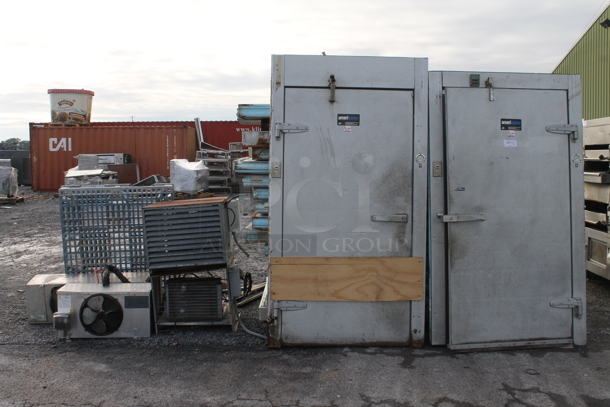
Hard-wear example—extensive corrosion and wear make food service restoration labor-intensive, but unit still valuable for alternative uses, parts, or panel replacement inventory
Value propositions in this tier: smoker conversion ($200-$500 materials creates commercial smoker), dry storage (weathertight shed for $500 is excellent), parts harvesting (doors, gaskets, panels, hardware), or panel replacement inventory for operators maintaining multiple walk-ins.
Don't expect food service functionality without $1,500+ refurbishment investment. Factor this accurately into bids.
$500-$1,000: Complete But Needs Work
This tier represents complete walk-ins requiring cleaning, gasket replacement, and likely some panel repair. Refrigeration systems may or may not be functional—budget for professional evaluation and potential repairs.
Typical condition includes surface rust (treatable), worn gaskets (replaceable), dirty refrigeration (cleanable), and minor panel damage (repairable). Total refurbishment costs typically run $800-$1,500 bringing units to serviceable condition.
If purchasing at $750 and spending $1,200 on refurbishment, total investment remains $1,950—excellent value compared to $5,000-$8,000 for comparable used equipment through dealers.
$1,000-$2,000: The Volume Sweet Spot
This tier represents 40% of auction sales. Units show acceptable cosmetic condition, appear mechanically sound, and likely came from closed restaurants with reasonable maintenance histories.
Budget for professional cleaning ($200-$400), gasket replacement ($100-$300), refrigeration servicing ($300-$600), and potential minor repairs. Total post-purchase investment typically runs $600-$1,300.
Combined purchase and refurbishment costs remain $1,600-$3,300—substantial savings versus $5,000-$10,000 for comparable equipment through traditional channels.
$2,000-$3,000: Better Condition, Higher Confidence
This tier (20% of sales) represents cleaner units, more recent models, or desirable configurations (combo boxes, larger sizes, premium brands). Cosmetic condition is good, completeness is guaranteed, and functionality probability is high.
Expect minor servicing only. Budget $500-$1,000 for professional commissioning, cleaning, and minor adjustments. Total investment remains $2,500-$4,000—still representing 40-60% savings versus new equipment.
$3,000+: BNSD and Premium Units
Brand-new scratch-and-dent units and premium equipment in exceptional condition occupy this tier. The $28,499 AmeriKooler represents extreme upper bound, but $3,000-$5,750 is common for BNSD units at auction.
These purchases eliminate functionality risk entirely. You're paying auction premium (2-3X median pricing) for brand-new equipment with cosmetic compromise only. Competition is fierce because value is obvious—experienced buyers recognize BNSD opportunities immediately.
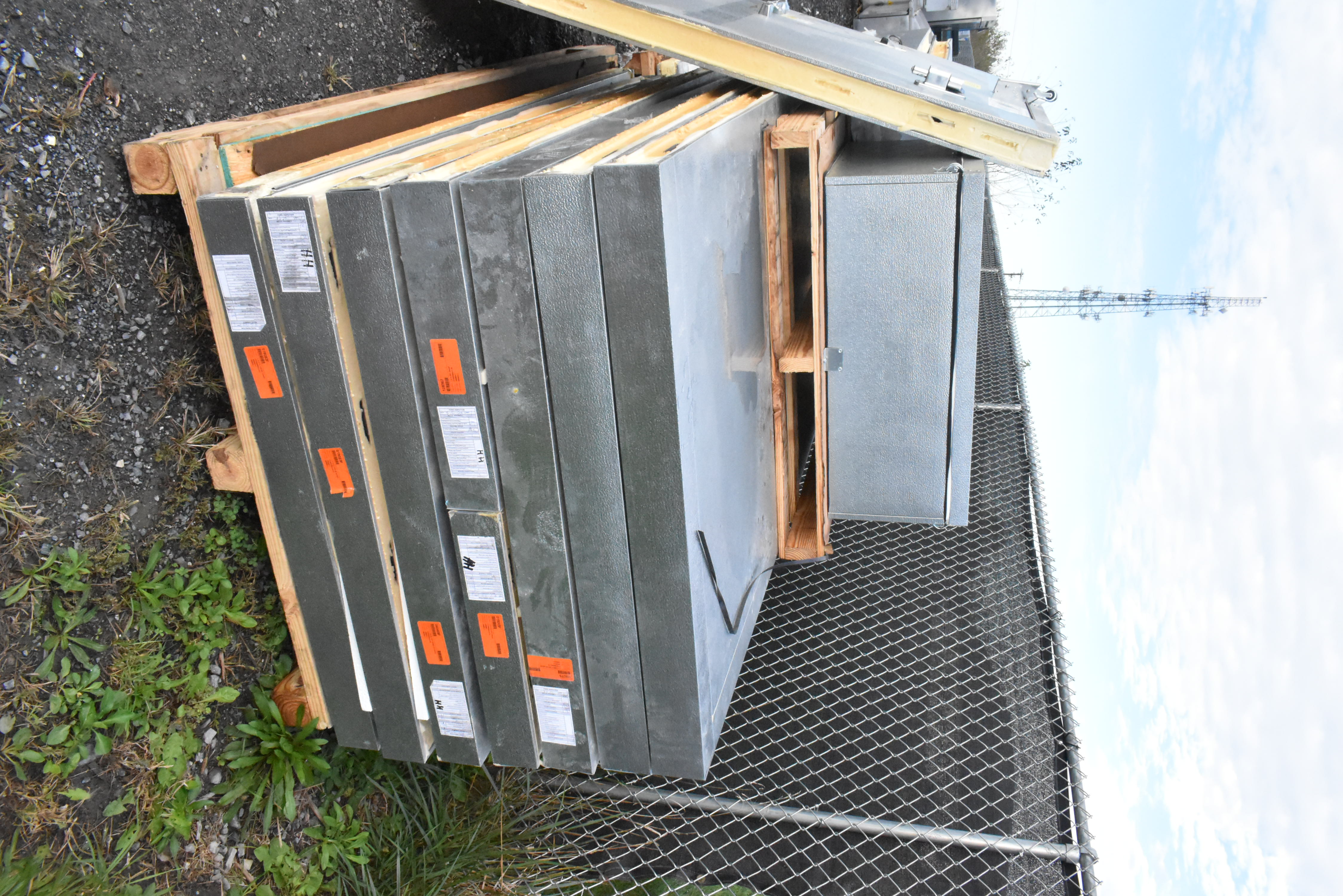
Brand new Nor-Lake 8'x16' walk-in ($5,750.01 sale)—BNSD equipment delivering full functionality with minor cosmetic damage at 30-50% below retail
Set maximum bids at 50-60% of retail pricing. If comparable new walk-in retails for $12,000, cap auction bids around $6,000-$7,200. This provides substantial savings while accounting for warranty loss and cosmetic issues.
The Bidding Discipline Requirement
Walk-in auctions appear weekly. Supply is consistent. Missing one auction knowing another walk-in will appear next week prevents overpaying through competitive heat-of-the-moment bidding.
Set maximum bids before auction starts. Write them down. Commit to walking away when bidding exceeds your threshold. Auction fever is real—emotional investment overrides rational pricing. Discipline protects profitability.
Final Assessment: When Walk-Ins Exceed Retail at Auction
The AmeriKooler selling for $28,499—exceeding manufacturer's suggested retail price—proves a fundamental thesis about secondary equipment markets: educated buyers pay premium pricing when value propositions align with operational needs.
This sale wasn't anomaly. It was inevitability. Twelve unique bidders understood they were purchasing immediate availability (next-day pickup vs 12-week ordering), confirmed quality (AmeriKooler reputation), perfect configuration (self-contained combo box in standard sizing), and 15+ years of reliable service. They calculated total value and determined auction pricing—even exceeding retail—represented better economics than alternative acquisition channels.
Value Proposition Summary
- Median auction price: $1,425.50 vs retail $8,000-$25,000+ for comparable new equipment
- Best risk-reward tier: $1,000-$2,000 (40% of market)
- Premium BNSD tier: $3,000-$5,750 (40-60% off retail)
- Top brands: Bally ($2,050 median), Kolpak ($1,540), Nor-Lake ($1,425.50)
- Service life: 13-18 years with proper maintenance
- Configuration premium: Combo boxes command 28% premium vs cooler-only units
The auction market rewards strategic thinking. With 64+ units appearing annually and median pricing around $1,425, supply consistently meets demand. Smart buyers focus on matching equipment to operational requirements rather than winning individual auctions.
Self-contained units dominate auction volume (54% market share) because they serve the broadest operator base without requiring external refrigeration infrastructure. Remote units deliver superior efficiency and longevity but demand professional installation and suitable facilities. The configuration choice shapes everything about walk-in ownership.
Brand selection matters over decades rather than days. AmeriKooler, Kolpak, Nor-Lake, Bally, and Master-Bilt command premiums through documented quality, but all major brands deliver adequate performance when properly maintained. The difference appears in operating costs, repair frequency, and ultimate service life.
Critical inspection focuses on completeness and panel condition. Cam lock corrosion reveals maintenance history more reliably than any other single indicator. Clean units with intact gaskets, minimal rust, and complete component sets deserve premium bids because condition predicts reliability.
Installation requires professional expertise for remote units (refrigerant handling demands EPA certification) and benefits from professional service even for self-contained configurations. Budget $1,500-$6,000 for complete installation depending on configuration and facility readiness.
Walk-ins reaching end-of-life for food service still deliver value through alternative uses. Smoker conversions, icebox applications, and dry storage repurposing extend useful life well beyond refrigeration functionality. This residual value supports aggressive bidding on damaged units unsuitable for food service restoration.
The auction market for walk-in coolers and freezers offers exceptional value across all operational scales. From $500 alternative-use candidates to $28,499 premium BNSD units exceeding retail pricing, understanding configuration tradeoffs, brand quality indicators, and condition assessment enables informed purchasing decisions delivering decades of reliable cold storage service.
Ready to Bid on Commercial Walk-In Coolers?
PCI Auctions offers 600-900 lots weekly of restaurant and foodservice equipment including walk-in coolers, freezers, refrigeration, cooking equipment, and complete restaurant liquidations. Preview in person at our Manheim, Pennsylvania facility, inspect equipment before bidding, and leverage auction pricing for your operation.
View Current Auctions